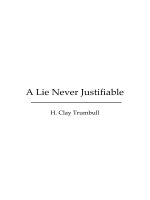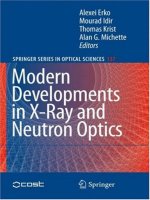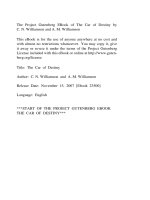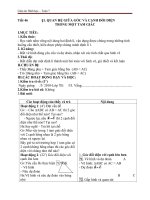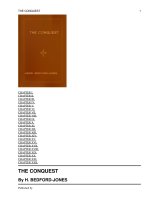Extinct Monsters by H. N. Hutchinson
Bạn đang xem bản rút gọn của tài liệu. Xem và tải ngay bản đầy đủ của tài liệu tại đây (14.82 MB, 356 trang )
THE
SEA
SERPENT
"
FODND.
The
last
Australian
mail
brings
news of
the
actual
discovery
of
a
sea
serpent.
The
Pacific
Islands
trading
steamer
Emu
has
arrived
in
Sydney
with a
portion
of
the
marine
monster on
board.
The
statement
of the
supercargo,
Mr
A.
H.
Bell,
is
as
follows:
"
When we
called
at
Suwarrow
Island,
on
our
way
back to
Sydney,
the
natives
told us
that a
big
devil-fish
had been
washed
ashore.
We
proceeded
along
the
beach
towards
the
spot
indicated,
and
onr
nostrils
were
soon
assailed
by
a
horrible
stench.
After
perils
by
sea
and
worse
perils
by
the
poisoned air,
we
got
close to
the
gigantic
animal.
We
secured as
much
of
it as
we
could,
and
we
have
now
on
board the
first
sea
serpent
ever
brought
to
Australia or
anywhere
else."
The
captain
corroborated
this
statement,
and
added
that
the
hide or
skin
of
the
monster
was
of
a
browmsu
colour,
and
covered
with
hair.
The
head
resembled
that
of a
horse.
He
estimated
the
length
at
60ft.,
and the
probable
weight
at
seventy
tons.
A
detailed
examination
showed
that the
ortion
of
the
sea
serpent
brought
by
the
Emu
were
:
skuJ,
measuring
3tt.
from
the
neck
to the
point
of
the
nose,
some
ribs
2ft. in
length,
and
the
spine
4ia. in
diameter.
There
was
evidence
of
two
tusks at
the
tremity
of the
lower
jaw,
and
the
natives
said
the
monster
had
flappers
like
a
seal
when
it
waa
originally
washed
ashore.
In
reply
to the
questions
as
to
why
he
did
not
bring
more
of
the
animal
with
him,
the
captain
said :
"
To
stay
longer
collecting
the
remains
would
have
nauseated the
collectors
beyond
recovery."
J.
he
discovery
has
aroused
so
much
interest
in
scientific
circles
in
Sydney
and
amongst
the
general
public
that
the
captain
of
the
Emu
has
agreed
to call
again
at
buwarrow
Island
on
his
next
trip
and
gather
up
the
remaining
fragments
of
the
sea-serpent
or
whatever
else
this
nncauny
leviathian
of
the
deep
may
have
been.
At
Kingston,
on
Saturday,
the
inquest
was
opened
oa
the
body
of
Mr
James
Grindley,
who,
it
is
supposed,
swallowed
toothache
mixture
in
mistake.
The
inquest
was
adjourned.
To
MOTHERS.
Mr
Winslow's
Soothing
Syrup
has
been used
over
fifty
years
by
millions
of
mothers f
or
tnsirchilclren
while
teethiug
with
perfect
success. It
soothes tho
child
softens
the
gums,
allays
all
pain,
cures
wind
colic,
and
is
the
be t
remedy
for
diarrhoea. Of
nil
Chemists.
IB
ijti.
Top
cor.
Park
Street,
BRISTV'
LIBRARIES &
BOOKS norm
.
.
-
MONSTERS.
MONSTERS.
A
POPULAR
ACCOUNT OF
SOME
OF
THE
LARGER
FORMS OF
ANCIENT
ANIMAL LIFE.
BY
REV. H. N.
HUTCHINSON,
B.A.,
F.G.S.,
AUTHOR OF "THE AUTOBIOGRAPHY
OF THE
EARTH,"
AND
"
THE STORY OF
THE
HILLS,"
WITH
ILLUSTRATIONS
BY
J.
SMIT
AND
OTHERS.
FIFTH
AND
CHEAPER EDITION.
LONDON:
CHAPMAN
&
HALL,
LD.
1897.
All
rights
reserved.
"The
possibilities
of
existence run
so
deeply
into the
extravagant
that
there is
scarcely any conception
too
extraordinary
for Nature to
realise."
AGASSIZ.
PREFACE
BY
DR.
HENRY
WOODWARD,
F.R.S.
KEEPER
OF
GEOLOGY,
NATURAL HISTORY
MUSEUM.
I
HAVE been
requested by
my
friend
Mr.
Hutchinson,
to
express my opinion upon
the series of
drawings
which
have been
prepared
by
that excellent artist of
animals,
Mr.
Smit,
for
this
little book
entitled
"
Extinct
Monsters."
Many
of the stories told
in
early days,
of
Giants and
Dragons,
may
have
originated
in
the
discovery
of
the
limb-
bones
of
the
Mammoth,
the
Rhinoceros,
or other
large
animals,
in
caves,
associated
with
heaps
of broken
frag-
ments,
in
which
latter
the
ignorant
peasant
saw
in
fancy
the
remains
of
the
victims devoured
at the monster's
repasts.
In Louis
Figuicr's
World
before
the
Deluge
we are
favoured
with several
highly
sensational views of
extinct
monsters
;
whilst the
pen
of
Dr. Kinns has furnished
valuable
information as to the
"slimy"
nature of
their
blood
!
The late
Mr.
G.
Waterhousc Hawkins
(formerly
a litho-
graphic
artist)
was for
years
occupied
in
unauthorised
restorations
of
various
Secondary
reptiles
and
Tertiary
mammals,
and
about
1853
he
received
encouragement
vi
PREFACE
BY DR. HENRY
WOODWARD.
from Professor Owen
to
undertake
the
restorations
of
extinct animals
which
still
adorn
the
lower
grounds
of the
Crystal
Palace
at
Sydenham.
But
the discoveries
of later
years
have
shown that the
Dicynodon
and
Labyrinthodon,
instead
of
being
toad-like
in
form,
we're lacertilian
or
salamander-like
reptiles,
with
elongated
bodies and
moderately long
tails
;
that
the
Iguanodon
did not
usually
stand
upon
"all-fours,"
but more
frequently
sat
up
like some
huge kangaroo
with short
fore
limbs
;
that the
horn on its snout was
really
on its
wrist
;
that
the
Megalosaurus,
with a more slender
form
of
skeleton,
had a
somewhat
similar erect
attitude,
and the
habit,
perhaps,
of
springing
upon
its
prey, holding
it
with
its
powerful
clawed
hands,
and
tearing
it with its
formidable
carnivorous
teeth.
Although
the
Bernissart
Iguanodon
has been to
us a
complete
revelation
of
what
a
Dinosaur
really
looked
like,
it is to
America,
and
chiefly
to
the
discoveries of
Marsh,
that we owe
the
knowledge
of a whole series of new
reptiles
and
mammals,
many
of
which
will be
found
illustrated
within these
pages.
Of
long
and
short-tailed
Pterodactyles
we now know
almost
complete
skeletons and details
of
their
patagia
or
flying
membranes. The
discovery
of the
long-tailed
feathered bird with teeth the
Archaeopteryx,
from
the
Oolite
of
Solenhofen,
is
another
marvellous
addition to
our
knowledge
;
whilst Marsh's
great Hesperornis,
a
wing-
less
diving
bird
with
teeth,
and
his
flying
toothed
bird,
the
Ichthyornis
dispar,
are to us
equally surprising.
Certainly,
both in
singular
forms of fossil
reptilia
and in
early
mammals,
North
America carries
off the
palm.
Of
these the
most remarkable are
Marsh's
Stegosaurus,
PREFACE
BY
DR.
HENRY WOODWARD,
vii
a
huge
torpid reptile,
with
very
small head and
teeth,
about
twenty
feet
in
length,
and
having
a series
of flattened
dorsal
spines,
nearly
a
yard
in
height,
fixed
upon
the
median
line
of its back
;
and
his
Triceratops,
another
reptile bigger
than
Stegosaurus, having
a
huge
neck-shield
joined
to
its
skull,
and
horns
on
its
head
and snout.
Nor
do the
Eocene mammals
fall short
of the
marvellous,
for in Dinoceras
we find
a beast with six
horns,
and sword-
bayonet
tusks,
joined
to
a
skeleton
like an
elephant.
Latest
amongst
the marvels
in modern
palsontological
discovery
has been that made
by
Professor
Fraas of the
outline
of the skin and
fins in
Ichthyosaurus
tenuirostris,
which
shows
it
to have
been
a veritable
shark-like
reptile,
with
a
high
dorsal fin and
broad
fish-tail,
so that
"
fish-
lizard
"
is more than
ever
an
appropriate
term for these
old
Liassic
marine
reptiles.
As
every palaeontologist
is
well
aware,
restorations
are
ever liable
to
emendation,
and
that the
present
and
latest
book of
extinct monsters will
certainly prove
no
exception
to
the
rule
is
beyond
a
doubt,
but
the author
deserves
our
praise
for the
very
boldness of
his
attempt,
and the
honesty
with
which
he has
tried
to
follow nature
and
avoid
exaggeration.
Every
one
will admire
the
simple
and un-
affected
style
in
which the author
has
endeavoured
to tell
his
story,
avoiding,
as far
as
possible,
all
scientific
terms,
so
as to
bring
it within the
intelligence
of the
unlearned.
He
has,
moreover,
taken
infinite
pains
to
study
up
his
subject
with
care,
and to
consult all
the
literature
bearing upon
it He
has
thus
been enabled
to
convey
accurate
information
in
a
simple
and
pleasing
form,
and
to
guide
the
artist
in
his
difficult task with
much
wisdom
and
intelligence.
That the
excellence
of the
sketches is
viii
PREFACE
BY
DR.
HENRY
WOODWARD.
due to
the
artist,
Mr.
Smit,
is a
matter
of
course,
and so
is the
blame,
where criticism
is
legitimate
;
and no
one
is
more sensible
of the
difficulties of the task than
Mr.
Smit
himself.
Speaking
for
myself,
I
am
very
well
pleased
with the
series
of sketches
;
and I
may say
so with
the
greater
ease
and
freedom
from
responsibility,
as
I
have had
very
little
to
do
with
them,
save
in one
or
two
trifling
matters
of
criticism.
I
may
venture,
however,
to
commend
them to
my
friends
among
the
public
at
large
as
the
happiest
set
of restorations
that has
yet
appeared.
H.
W.
LATE
SIR
RICHARD
OWEN
AND
A
SKELETON
OF DINORNIS
MAXIMUS.
PLATE XXIV. (From
a
fhotografh.')
AUTHOR'S
PREFACE.
NATURAL
history
is
deservedly
a
popular
subject.
The
manifestations
of life
in all
its
varied forms is a theme
that
has
never
failed
to
attract
all who are
not destitute
of
intelligence.
From the
days
of
the
primitive
cave-
dwellers
of
Europe,
who lived
with mammoths and other
animals
now lost
to the world
;
"of the ancient
Egyptians,
who drew and
painted
on
the walls
of
their
magnificent
tombs
the
creatures
inhabiting
the delta of the
Nile
;
of
the
Greeks,
looking
out
on
the world
with
their
bright
and
child-like
curiosity,
down to our own
times,
this
old,
yet
ever
new,
theme
has never
failed. Never
before
was
there
such
a
profusion
of
books
describing
the
various
forms of
life
inhabiting
the
different countries of
the
globe,
or the
rivers,
lakes,
and seas
that
diversify
its
scenery.
Popular
writers have done
good
service in
making
the
way plain
for those who
wish to
acquaint
themselves
with
the
structures,
habits,
and
histories of
living
animals
;
while
for
students a still
greater
supply
of
excellent
manuals
and
text-books has
been,
and
still
continues to
be,
forthcoming.
But
in
our
admiration
for
the
present
we
forget
the
great past.
How
seldom do
we
think of that innumerable
x
AUTHOR'S
PREFACE.
host
of creatures
that
once trod this
earth ! How little
in
comparison
has
been done for them
!
Our
natural-history
books
deal
only
with those that
are
alive
now. Few
popular
writers have
attempted
to
depict,
as
on
a
canvas,
the
great
earth-drama that
has,
from
age
to
age,
been
enacted
on the
terrestrial
stage,
of which we
behold
the
latest,
but
probably
not the
closing
scenes.
When our
poet
wrote
"
All the world's a
stage,"
he
thought
only
of "men and
women,"
whom
he
called
"merely
players,"
but
the
geologist
sees a wider
applica-
tion
of these
words,
as he reviews the drama
of
past
life
on the
globe,
and finds
that
animals, too,
have had
"
their
exits and
their entrances
;
"
nay
more,
"
the
strange
eventful
history
"
of a
human
life,
sketched
by
the master-
hand,
might
well be chosen
to illustrate the birth and
growth
of the tree of
life,
the
development
of which we
shall
briefly
trace
from
time to
time,
as
we
proceed
on
our
survey
of
the
larger
and more wonderful
animals of life
that
flourished
in
bygone
times.
We
might
even make out
a
"
seven
ages
"
of the
world,
in each
of
which some
peculiar
form of
life
stood out
prominently,
but
such
a
scheme
would
be
artificial.
There is a wealth of material for
reconstructing
the
past
that
is
simply bewildering
;
and
yet
little
has been
done
to
bring
before the
public
the
strange
creatures that
have
perished.
1
To the
writer
it is
a matter of
astonishment
that
the
1
Figuier's
World
before
the
Deluge
is
hardly
a
trustworthy
book,
and is
often
not
up
to date. The restorations
also are
misleading.
Professor
Dawson's
Story
of
the Earth
and Man
is
better
;
but
the illustrations are
poor.
Nicholson's
Life-History
of
the
Earth
is a
student's book.
Messrs. Cassells' Our
Earth
and its
Story
deals with
the whole
of
geology,
and so
is too
diffusive
;
its
ideal
landscapes
and
restorations leave much to
be desired
AUTHOR'S
PREFACE,
xi
discoveries
of
Marsh,
Cope,
Leidy,
and others in
America,
not
to mention some
important European
discoveries,
should have attracted
so little notice
in
this
country.
In
the far and wild
West a
host of
strange
reptiles
and
quad-
rupeds
have been
unearthed from
their
rocky sepulchres,
often
of
incredibly huge
proportions,
and,
in
many
cases,
more weird and
strange
than the
imagination
could
con-
ceive
;
and
yet
the
public
have
never
heard of
these
discoveries,
by
the
side
of
which the
now
well-known
"lost
creations"
of
Cuvier, Buckland,
or
Conybeare
sink
into
the shade.
For
once,
we
beg
leave to
suggest,
the
hungry
pressman,
seeking
"
copy,"
has
failed to
see
a
good
thing. Descriptions
of
some of
"
Marsh's
monsters
"
and
how
they
were
found,
might,
one
would
think,
have
proved
attractive to
a
public
ever on the
look
out for
something
new.
Professor
Huxley,
comparing
our
present
knowledge
of
the
mammals of the
Tertiary
era with
that
of
1859,
states
that the discoveries of
Gaudry,
Marsh,
and
Filhol,
are
"
as
if
zoologists
were to
become
acquainted
with
a
country
hitherto
unknown,
as rich in novel
forms of life
as
Brazil
or South
America
once
were to
Europeans."
The
object
of
this book is
to describe
some
of
the
larger
and
more
monstrous forms of
the
past
the lost
creations
of
the old world
;
to clothe
their
dry
bones
with
flesh,
and
suggest
for
them
backgrounds
such as are
indicated
by
the discoveries
of
geology
:
in
other
words,
to
endeavour,
by
means
of
pen
and
pencil,
to
bring
them back to
life.
The
ordinary public
cannot learn
much
by
merely
gazing
at
skeletons set
up
in
museums.
One
longs
to cover
their
nakedness
with
flesh and
skin,
and
to
see them as
they
were
when
they
walked
this
earth,
xii AUTHOR'S PREFACE.
Our
present imperfect
knowledge
renders it difficult
in
some
cases to
construct
successful restorations
;
but,
never-
theless,
the
attempt
is
worth
making
:
and if some who
think
geology'
a
very dry subject,
can
be converted
to a
different
opinion
on
reading
these
pages,
we
shall be
well
rewarded
for
our trouble.
We venture
to
hope
that those who will take
the
trouble
to
peruse
this
book,
or even to
look
at its
pictures,
on
which
much
labour
and
thought
have
been
expended,
will find
pleasure
in
visiting
the
splendid
geological
collection at
Cromwell
Road.
We
have often
watched visitors walk-
ing
somewhat
aimlessly among
those
relics
of
a former
world,
and
wished
that we could
be
of
some
service.
But,
if
this
little
book should
help
them the
better to
understand
what
they
see
there,
our
wish
will be
accomplished.
Another
object
which
the
writer has
kept
in
view
is
to
connect
the
past
with
the
present.
It
cannot
be too
strongly urged
that the best
commentary
on
the
dead
past
is
the
living present.
It
is
unfortunate that there is still
too
great
a
tendency
to
separate,
as
by
a
great gulf,
the
dead from the
living,
the
past
from the
present,
forms of
life.
The
result of this
is
seen in our
museums. Fossils
have too often
been left
to the
attention
of
geologists
not
always
well
acquainted
with
the structures
of
living
animals.
The more
frequent
introduction
of
fossil
specimens
side
by
side with
modern forms
of
life would not
only
be
a
gain
to
the
progress
and
spread
of
geological
science,
but would
be
a
great
help
to
students
of
anatomy
and natural
history.
The tree of life is
but a
mutilated
thing,
and half its
interest
is
gone,
when the dead
branches are
lopped
off.
It
is,
perhaps, justifiable
to
give
to
the term
"
monster"
a
somewhat
extended
meaning.
The writer
has
therefore
AUTHOR'S
PREFACE.
xiii
included
in his
menagerie
of
extinct
animals
one
or
two
creatures
which,
though
not of
any
great
size,
are neverthe-
less
remarkable
in
various
ways
such,
for
instance,
as
the
winged
reptiles,
and
anomalous
birds
with
teeth,
of later
times,
and
others.
Compared
with
living
forms,
these
creatures
appear
to
us
as
"monstrosities,"
and
may
well
find
a
place
in our
collection.
The
author
wishes,
in
a
few
words,
to
thank
those
friends
who
have
rendered
him assistance
in his task.
Dr.
Henry
Woodward,
F.R.S.,
Keeper
of
Geology,
Natural
History
Museum,
has
from the first taken
a
lively
interest
in
this
little
book.
He
kindly helped
the
author with his
advice
on difficult
matters,
criticising
some
of
the artist's
preliminary
sketches
and
suggesting improvements
in the
restorations.
With
unfailing courtesy
he
has
ever
been
willing,
in
spite
of
many
demands
on his
time,
to
place
his
knowledge
at the
disposal
of
both the author
and
artist
;
and
in
this
way
certain
errors
have
been
avoided.
Besides
this,
he
took
the trouble to read
through
the
proof-
sheets,
and made
suggestions
and corrections which
have
greatly
improved
the text.
For
all this welcome aid the
author
begs
to return
his
sincere thanks.
To
Mr.
Smith
Woodward,
of the
Natural
History
Museum,
the
author is
also much indebted for his
kindness
in
reading
through
the
text and
giving
valuable
informa-
tion
with
regard
to the
latest
discoveries.
The
artist,
Mr.
Smit,
notwithstanding
the
novelty
of
the
subject
and the
difficulties of the
task,
has thrown
himself
heartily
into
the work of
making
the
twenty-four
restorations
of
extinct
animals.
To
him,
also,
the
author
is
greatly
indebted,
and
considers
himself
fortunate
in
having
secured the services of
so
excellent an
artist.
xiv
AUTHOR'S
PREFACE.
To
the
publishers
his
thanks are
due for their
liberality
in the matter
of
illustrations,
and
the
readiness
with
which
they
have
responded
to
suggestions.
With
regard
to minor illustrations the
following
acknow-
ledgments
are
due
:
To the
Palaeontological Society
of Great
Britain for
permission
to
reproduce
three of the
illustrations
in
Sir
Richard Owen's
great
work,
British Fossil
Reptiles, pub-
lished
in their
yearly
volumes,
viz.
Figs.
3, 4,
and 8.
To Messrs.
Bell and Co.
for
the
following
cuts from
the
late
Dr. Gideon A.
Mantell's
works:
viz.
Figs.
12,
14,
20,
33,
37,
38.
To Messrs.
A. and
C.
Black for the
following
cuts
from
Owen's
Paleontology
:
viz.
Figs.
51, 54, 56,
57.
Appendix
IV.
contains
a list of some of the
works of
which
the
writer
has made use
;
but it
would
be
impossible
within
reasonable
limits to
enumerate
all
the
separate
papers
which
have
necessarily
been
consulted.
The
reader
will
find
numerous
references,
such as
"
Case
Y on
Plan,"
in
brackets
;
these
refer
to the
plan
given
at the end of
the
excellent
little Guide to
the Exhibition Galleries in the
Department
of Geology
and
Paleontology
in the Natural
History
Museum,
Cromwell Road
(price
one
shilling),
which
visitors
to
the Museum are advised to
obtain.
PREFACE TO
SECOND EDITION.
THE
appearance
of a
second edition affords the author
a
pleasant
opportunity
of
thanking
the
reading
public,
and
the
Press,
for the kind
way
in
which
his
endeavour
to
popularise
the results
of modern
Paleontology
has been
received. There
seem to be fashions
in all
things
even
in sciences
;
and
perhaps
the wonderful advances we
have
witnessed
of late
years
in the
physical
sciences
on the one
hand,
and
in
biological
sciences on the
other,
may
have
tended to
throw
Palaeontology
somewhat
into
the
shade.
Let
us
hope
that it
will
not
remain
there
long.
A
large
number of
illustrations have
been
added
for the
present
edition,
besides additional
matter here and there
in the text.
Three of the
plates (viz.
Plates II. X.
XV.)
have been redrawn.
Plate
II. shows the
Ichthyosaurus
a.s
interpreted
by
the latest
discovery
from
Wurtemburg.
Plate X.
gives
a somewhat
different
interpretation
of the
Stegosaurus, suggested
by
some remarks of
Mr.
Lydekker.
A
slight change
will be
noticed
in
Plate XV.
(Brontops).
Plate
XVII.
is a
great
improvement
on
the old
drawing
(Fig.
28,
old
edition)
of the
Megatherium
skeleton. Plate
XXIV.,
besides
containing
a
valuable
portrait
of the late
Sir
Richard
Owen,
gives
another
drawing
of
the
Dinornis
skeleton.
April,
1893.



